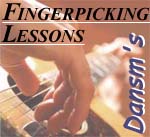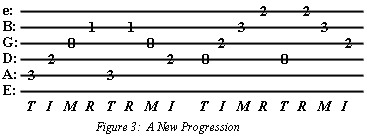
More Complex Picking Patterns
Once you have learned how to pick, you can begin to learn new chords and
to make up your own picking patterns. Basically I will outline patterns
on common chords, and allow you to invent different ones and to play around
on more obscure chords.
- Now we will study a pattern for the D chord. This pattern is very similar
to the C chord pattern except different strings are used. Simply shift your fingers
up one string, so the thumb is playing the 4th string, as shown in Figure
1.

- This pattern should be relatively simple, because it is just a repeat of
the previous pattern. However, it may take some time to get used to the feel of the
new strings. Once you feel comfortable playing this, move on to the next step.
- This should sound like the first measure of R.E.M.'s
Everybody Hurts, just so you know.
- Now I will introduce a new pattern, based on the C and D
chord patterns learned above. This new pattern is shown in
Figure 2. Notice that in the middle of this exercise you must change your finger
position to switch between the C and D chord.

- After you have played the C chord through once, as shown in the figure,
you must move your thumb up one string (to 4th string), and move your other fingers up
in the same manner.
- This exercise is not complicated except for the transition between chords.
Concentrate on this transition, because it will be very important when you begin to play
songs.
- Once you feel comfortable changing chords, you can learn a new pattern
of picking, shown in Figure 3. Start slowly, and work up to speed; you have never
seen this pattern before.

- When you play this exercise, play the bass note of the chord
(e.g. C for a C chord, D for a D chord, etc.) on the strong beats, as is notated.
Play this exercise slowly, because it is the first time you will be playing strings out
of order.
- The most important thing to notice about this exercise is the repeated
use of the bass note of the chord. Most picking patterns that I do try to emphasize the bass
note of the chord, because I believe it is important for a solid-sounding chord.
-
Proceed
only when you feel comfortable playing Figure 3.
Move on to the fifth lesson!
Go back to the third lesson
You are visitor number
 since 2-15-97
since 2-15-97
© 1997 Daniel E. Smith.



